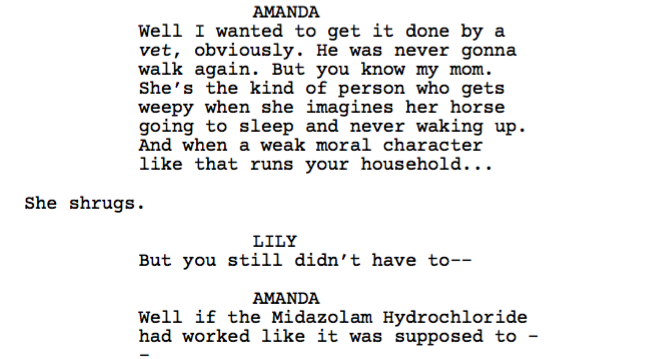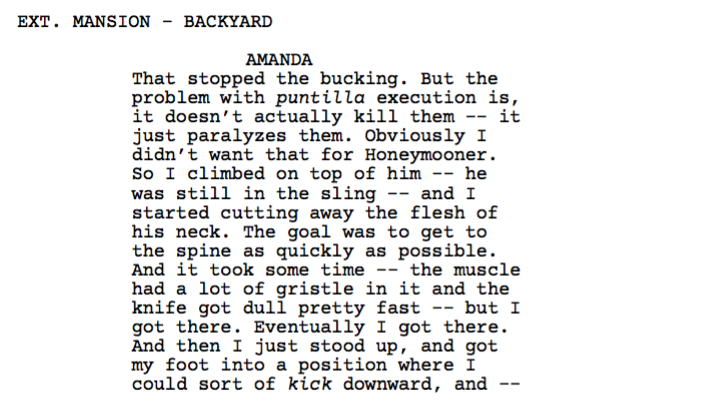This week, Jorge goes into the stables to talk a murderous teenage girl rampage.

Films come from many sources - novels, comic books, video games. The stage has been one of the largest pools of not only source material for the screen, but also of playwrights that eventually make the jump to Hollywood.
Thoroughbreds was conceived and thought of as a play. It tells the story of two teenage girls (one without empathy; the other one with too much) plotting the murder of one of their abusive stepfathers. As the project evolved, writer-director Cory Finley realized it would be better told as a film. However, its stage roots are still very much present in the text.
Let’s take a look at a particularly theatrical moment, a monologue in which one of the girls recalls her actions, and in doing so puts forward her entire character...
Thoroughbreds
Written by: Cory Finley
Lily and Amanda get together in the backyard of a luxurious mansion. At this point in the movie, they have started to form an unlikely and hesitant friendship. Amanda has been isolated from the rest of the community because of some atrocious (and to us, still unknown) thing she did to her horse. Lily is living in an abusive household with his mom and stepdad. Heightened by deadpan dialogue, perfectly centered shots, and bright color palettes, couldn’t be more thematically opposite.
Lily has seen pictures of the dead horse. And she is intrigued. Amanda previously suggested they should get rid of her stepdad, and these pictures are the proof that she may actually know what she’s talking about. This scene starts off inquisitively.

***

Amanda is not someone who shares her feelings. She claimed earlier that she has none. But as soon as Lily gives her an opening to start talking (not venting, or sharing; simply talking), she goes on a detailed and lengthy description on why exactly she killed her horse the way she did.
This is where the stage origins of the screenplay are the most evident. It is dialogue that is definitely too long and detailed for the standard screenplay; it goes on for almost four pages. It takes its time to develop itself. It doesn’t cut back on the details. The punctuation and sentence structure is very specific, almost lyrical. And it plays heavily on theme: this entire story is just a big analogy for how Amanda sees the world, her actions and herself. It uses an anecdote to paint a character.
The action lines are also extremely limited, letting the words take center stage. It is set in a single location, with only two characters; more reminiscent of how a play would be staged than a movie.

However, Finley also understands that this is, after all, not a play. And he makes choices in the page that could only be displayed cinematically, mainly the use of flashbacks. But the biggest visual cues came in the final product, and do not appear on the page.
Through his use of the camera, he carefully chooses what, who, and in which ways to show what’s on the frame. In the film, as Amanda delivers this monologue (through Olivia Cooke’s perfectly deadpan performance), there’s a slow, uninterrupted close-up zooming into Lily’s face, who’s making her own realizations. The page makes this monologue about Amanda; the camera makes it about Lily.
This conversation ends up being a pivotal moment in their relationship. It allows them to fully understand each other, and what they are willing to do for their survival. So they can start feeling, or stop feeling. They are now ready to take the next step into what ultimately will be their downfall. But that’s for another piece.